90 ◾ Healthcare Value Proposition
retrospective study period of a year or longer with cases selected throughout this period. This reduces bias due to seasonal variations or interruptions in the event cycle. One of the challenges of retrospective data is that it is often incomplete, with individual or entire portions missing due to misplacement. Alternatively, the data was never captured. In addition, the validity of retrospective data is often difficult to ascertain. Prospectively collected data are usually more likely to be complete. Prospectively collected data may suffer from biases because providers are aware that their behavior is being observed during the study period. The following are the various methods for collecting data: ◾◾ Observation ◾◾ Focus groups and interviews ◾◾ Surveys ◾◾ Documents and records ◾◾ Experimentation In what follows, each method of data collection will be described in greater detail.
Observation Observation, particularly participant observation, has been used in a variety of disciplines as a tool for collecting data about people, processes, and cultures in qualitative research. Marshall and Rossman (Marshall and Rossman, 1989) define observation as “the systematic description of events, behaviors, and artifacts in the social setting chosen for study” (p.79). Observations enable the researcher to describe existing situations using the five senses, providing a “written photograph” of the situation under study (Erlandson et al., 1993). Participant observation is the process that enables researchers to learn about the activities of the people under study in the natural setting through observing and participating in those activities. It provides the context for developing sampling guidelines and interview guides (DeWalt and DeWalt, 2002). Schensul, Schensul, and LeCompte (1991) define participant observation as “the process of learning through exposure to or involvement in the day-to-day or routine activities of participants in the researcher setting” (p.91). When feasible, direct observation allows the data collector to use all five senses in the data gathering process. The quality of the information











